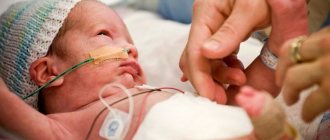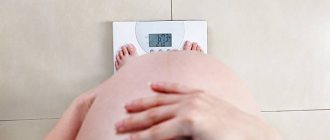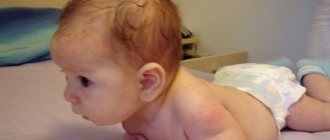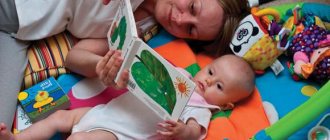The development of a child from month to year is of interest to many parents who are worried about their baby. In the first year of life, a child learns many actions and manipulations, such as sitting or standing, crawling, holding or grasping, smiling, playing, etc. During this year, the baby will have to overcome a lot of achievements and make a huge leap in his own development. After all, a baby from a previously absolutely helpless baby turns into a small individual who knows how to sit up, move independently, and express his own “wants” and other needs.
Norms for the development of a child up to one year old by month exist to determine the adequacy of the baby’s development. If a baby is raised in a “normal” social unit, in which two parents provide him with care, proper care and a prosperous existence, then a healthy toddler will develop evenly from month to year in all areas.
Thus, the physical development of a child up to one year by month implies an increase in body weight and its rapid growth. In the cognitive sphere of the child’s development, the emergence of the ability to remember and rapid learning will be observed from month to year. In the social development of a child, a response to the surrounding reality is observed, which is manifested by distinguishing the faces of loved ones and interest in various objects. In the motor sphere of a child’s development, the strength appears from month to year to first hold the head independently, and then sit and take the first steps.
How does a baby develop by 2 months?
At this age, the baby sleeps noticeably less: periods of prolonged daytime wakefulness appear. Daytime sleep is shortened. A night sleep pattern is being developed: now its duration is 10 - 12 hours with breaks for feeding, during which the baby may not wake up completely. Physical development:
- Lying on your stomach, hold your head at an angle of 45 degrees for some time;
- Rolls over from side to back;
- Holds the head in an upright position for 1 – 2 minutes;
- Follows moving objects with his eyes;
- Turns his head towards the sound;
- Hypertonicity of the hands disappears;
- Some reflexes of the newborn (grasping, walking reflex) fade away.
Psycho-emotional development:
- Demonstrates a “revival complex” - active movements of the arms and legs in response to the appearance of the mother, humming, a wide smile;
- Freezes, listening to sounds;
- Smiles in response to affectionate treatment, conversation, smile;
- Reacts to familiar voices;
- He hums and sings some sounds.
The development of perception of shape and color can be stimulated by hanging pictures with bright, clear shapes and patterns on the sides of the crib: black and white, red, yellow, blue, green, orange.
What can a baby do by 3 months?
Perhaps the main achievement of this month and joy for parents is the emergence of a routine that the baby builds together with his mother. There is already a distinct time of waking up, feeding and falling asleep with two or three (sometimes four times) daytime sleep.
At this age, the baby already knows how to express his dissatisfaction by screaming and crying and requires attention. Observant parents can notice the first manifestations of a child’s character.
Physical development:
- Holds his head confidently when lying on his stomach and in an upright position;
- When lying on his stomach, he rests on his forearms;
- Examines and sucks hands;
- Rolls from back to side;
- Tries to grab and hold the toy in his hand, and then pulls it into his mouth.
Psycho-emotional development:
- Maintains eye contact;
- Smiles and laughs;
- It can hum for a long time, the humming becomes varied;
- Recognizes the faces of loved ones;
- Fixes gaze on stationary objects for a long time (up to 5 minutes).
Arrange a family council and make a list of character traits of the baby's close relatives. Pay special attention to undesirable qualities. This is a good reason to start thinking about what methods of education could help correct them, and which ones will help develop those qualities that you dream of seeing in your heir.
Primary development
After birth, the first month of a baby’s life is adaptive. He learns to adapt to a new world outside his mother's tummy. At this time, the baby still sleeps a lot - up to 20 hours a day - and eats a lot.
The main task of parents at this time is to provide comfortable living conditions. To do this, you should create the required temperature in the room, change diapers and make sure that the baby is well-fed.
In the first two to three weeks, the ears of a newborn baby are still filled with fetal fluid and he perceives only loud sounds. By the end of the first month, he already hears a voice. It is important for parents to sing songs to their child, read fairy tales and talk to him so that he knows the voice of mom and dad. It is also recommended to take him in your arms more often so that he feels the love and warmth of his parents.
By the age of one month, the baby is already able to distinguish colors and observe bright toys, following them with his eyes. The baby learns to concentrate on a stationary object or the face of the parents. If you put the baby on his tummy, then by the age of one month he should be able to hold his head for several seconds.
In the first month after birth, the baby gains from 90 to 150 grams per week. During this time, the baby manages to gain up to 700 grams by the second month. He eats up to 5 times a night and every two hours during the day.
During the first month, the child is visited weekly by a pediatrician and twice a week by a nurse. Around the seventh to tenth day, the umbilical cord falls off, and by the end of the first month the newborn’s skin acquires a natural color.
Read more: All about baby development from 0 to 1 month
Baby development by 4 months
At 4 months, the main thing for a child is coordination of eye and hand movements. The grasping reflex gradually weakens, hand movements become conscious and take on meaning, especially when you need to reach something, the grasping reflex gradually fades away. It is your own hands (and sometimes even feet) that become the baby’s most favorite toys.
Active salivation may appear - this is how teeth begin to erupt. Don't be surprised if this happens only after a couple of months or more.
Physical development
- On his own or with the help of an adult holding him by one hand, he turns over from his back to his stomach (and sometimes from his stomach to his back);
- Reaches for objects, feels them;
- He licks his fingers, sucks his fist, and for the same purpose tries to reach the legs to his mouth;
- Rhythmically jerks its legs and transfers weight to them;
- Hypertonicity of the legs disappears.
Psycho-emotional development
- In communication he gives preference to his mother, recognizes her, rejoices when she appears, can be capricious when she leaves for a while;
- “Coos” with his parents when he is in a good mood;
- Actively smiles, laughs, squeals with delight;
- Reacts to the sound of his name;
- Can spend a long time occupied with toys hanging over the crib;
- Babbling appears and the first syllables are “ma”, “ba”, “pa”.
Features of the very first month
The first month is considered the most difficult for new mothers. During this period, the newborn baby adapts to new conditions and learns about the world around him.
Since he lived in his mother’s womb, he is interested in every moment - colors, the smile of mom, dad, people’s voices, positive or negative emotions.
It is worth noting! In the first month of life, the baby sleeps 70% of the time. Premature babies sleep more. It is through sleep that the body is replenished with energy, the immune system is strengthened, and the defenses are increased. In a dream, a child grows; on average, in the first month, babies grow by 2-3 centimeters.
In the first month of life, a boy and a girl should be able to:
- The movements are chaotic, the fists are in a compressed state.
- When lying on the abdomen, the child tries to raise his head.
- signals and requests by crying.
- , he can fix his gaze on a certain object, for example, on his mother’s smile, on hanging toys.
- In the first month of life, the child reacts to various sound signals - a bell, the music of toys, a bell. Many doctors recommend exposing your baby to music while she is in the womb. Moreover, now there is a wide variety of music for pregnant women.
- He knows his mother's smell, reacts sharply to it and can feel it from a distance.
- He develops thinking, he can react to certain sounds and colors.
- With constant communication, by the end of the first month the baby may produce certain vowel sounds - humming, cooing.
Developmental stages at 5 months
The fifth month passes under the motto “I want to move!” Let the baby continue to try to roll over, rock, and sit down, the main thing is to ensure his safety at these moments. If you notice that your baby needs more space than he has in his crib or playpen, you can lay him out on the floor. Prepare the surface for this in advance: it should be clean and pleasant for contact with the baby’s delicate skin; a soft mat is perfect for these purposes.
During this period, the sleep, wakefulness and feeding patterns may begin to change again. Sometimes the baby may not wake up all night, even for feeding, or get up very early and no longer get enough sleep in the morning.
Physical development
- Lies on his stomach for a long time, leaning on his outstretched arms, and may begin to crawl on his bellies;
- Confidently rolls over from back to stomach;
- Sits with support, while the back is strongly bent;
- Entertains himself by playing with his own arms and legs;
- Confidently grabs objects and holds them in his hands for a long time.
Psycho-emotional development:
- Recognizes mother's voice;
- Distinguishes the faces of loved ones from strangers;
- Reacts differently to different tone of address - smiles in response to an affectionate tone of voice and frowns when there is a strict intonation;
- It hums long and melodiously;
- He himself encourages parents to communicate - he smiles, babbles, stretches his arms; gets capricious if there is not enough communication.
At this age, children often confuse day with night (this feature can appear earlier, but is more common between 4 and 6 months). Think about why: maybe your baby has too long naps, or he doesn't get enough exercise during the day, or the air in the room is too dry and warm.
Development of a seven-month baby
At this age, applied abilities are highlighted. Now the child not only absorbs new things, but also learns to apply them in life. He can distinguish large objects and shows them. By the end of the month, he normally develops the skill of walking. The baby can no longer hold his body suspended for a short time and is able to stand with support.
A seven-month-old baby can sit independently. He happily throws toys and bangs them. The baby easily turns over onto his stomach and back. This is a real fidget who finds it difficult to sit still.
Now the child can be alone in the crib for quite a long time and babble. But most of all he loves to explore his mother’s face with his hands, leaf through books and try to assemble a pyramid.
Read more: All about a baby’s skills at 7 months
How does a baby develop at 6 months?
What would you like to eat? Yes, it is at six months that the baby begins to show interest in food. This is a new stage in its development, and not at all evidence of a lack of milk in the mother or malnutrition of the child. From 6 months you can introduce the first complementary foods.
Physical development
- Sits down from a position on all fours;
- Rolls over from stomach to back and from back to stomach;
- Gets on all fours and rocks back and forth, preparing for full crawling (some children are already quite good at crawling);
- Follows the movement of the toy for a long time;
- The first tooth may emerge.
Psycho-emotional development
- Deals with one object - moves from hand to hand, pulls into mouth, moves away, examines;
- Repeats syllables and sounds after an adult, imitating his voice intonations;
- Tries to imitate the movements of an adult - pats, knocks, squeezes, shakes a toy;
- The consonants “z”, “s”, “v”, “f” appear.
The baby still puts everything in his mouth into his mouth, and if your baby has already crawled, be on the lookout. Carefully check the apartment to ensure it is safe for your child to move around it. To do this, put yourself in the baby’s position in the literal sense: get on your knees and crawl across the entire apartment (or that part of it in which you will place the baby on the floor), removing any objects (perhaps even changing the arrangement of furniture) that pose a danger to the child. baby. Pay special attention to wires, sockets and heavy objects that your baby could knock over.
Development calendar
A special monthly calendar helps track a child's development. With its help you can understand how harmoniously the baby is growing. A calendar is needed to track height, weight, motor skills and emotional development.
Month one
The development of a child up to one year is monitored at regular visits to the pediatrician on a monthly basis. The first month is a transition period, the baby’s adaptation to life outside the womb.
The child learns:
- be in an air environment instead of a water environment;
- receive nutrition independently through sucking;
- regulate heat exchange;
- contact mom.
In the first month, the pattern of sleep and wakefulness is not established - the baby has not yet developed circadian rhythms. He may confuse day and night. The shallow phase of sleep prevails over the deep phase, so the child is easy to wake up.
The baby feeds approximately every 2 hours, as breast milk is absorbed quickly. WHO recommends breastfeeding on demand. If this is not possible, you should choose a high-quality milk formula.
The newborn needs frequent feedings and wakes up 2 to 6 times at night. The average time spent awake during the day between naps is 40-60 minutes.
Within a month from the date of birth, the child’s appearance changes. Physiological jaundice of newborns, acne disappears, swelling goes away, the skin acquires a natural color.
The period is often accompanied by infant colic. This disease is associated with the immaturity of the gastrointestinal tract, begins to manifest itself at about 3 weeks from the moment of birth, and goes away on its own. You can help your child with a special abdominal massage - stroking clockwise. Warming also helps - carrying the baby in your arms “belly to belly”.
The main signs of normal physical development of the baby by the end of the first month:
- can hold the head for 2-3 seconds while lying on the stomach;
- limbs are in good shape, pressed to the body;
- movements are chaotic;
- begins to be interested in contrasting pictures and toys;
- distinguishes mother from other adults;
- may begin to repeat the facial expressions of adults, smile;
- a buzz appears.
Physical development during this period occurs slowly. The only exercise for a child is laying on his stomach. Manipulation will help strengthen the neck muscles to support the head and is a good prevention of gas formation.
Prosperous psycho-emotional development is closely related to the mother’s behavior towards the child. The first three months after birth are also called the “fourth trimester of pregnancy” or the “gestation” period. This is due to the fact that the child needs physical contact with the mother.
Second month
The development of a child up to one year by month should be under the close attention of the mother and immediate environment, since during this period the baby grows faster than in any other period of life.
The second month is considered the final stage of the baby's adaptation to life outside the womb. Periods of wakefulness are lengthened, and nighttime sleep can be 10-12 hours with obligatory awakenings for feeding. The waking time between naps is from 1 hour 15 minutes to 1 hour 20 minutes. If you miss the optimal time to fall asleep, your child may stay awake longer, but it will be more difficult to put him to sleep.
The child has already adapted to the new way of getting food. Babies who are exclusively breastfed may experience stool retention for up to a week. This condition is considered normal if the baby does not show concern, and is due to the fact that breast milk is absorbed almost completely.
At 2 months the child:
- holds head up to 20 seconds;
- follows the toy with his eyes;
- the tone of the limbs gradually disappears, the hands are the first to relax;
- when he sees his mother and other familiar adults, he turns on a “revival complex”;
- hums confidently;
- examines his hands;
- the grasping reflex and the walking reflex disappear;
- turns when he hears speech;
- distinguishes the mother's voice from everyone else;
- holds a light toy in his hands.
At the age of 2 months, in addition to laying on the stomach, the first complex of massage and gymnastics is added. In addition to the development of motor skills, massage and gymnastics contribute to general hardening, which has a beneficial effect on the child’s immunity.
Third month of baby's life
Most children have an approximate sleep-wake schedule at 3 months. It is important not to break it and avoid overwork. Good sleep is as beneficial for development as food and activities with mom.
The optimal wake time is from 1 hour 20 minutes to 1 hour 35 minutes. If signs of fatigue appear, it is better to start going to bed, since overexcitement of the child interferes with good sleep.
The baby's main food is breast milk or formula; introducing complementary foods is not yet recommended.
Along with food, you need to ensure the supply of a sufficient amount of the vitamin, which is lacking in breast milk. To prevent rickets, the pediatrician prescribes vitamin D drops (500 IU daily). For artificial feeding, the supplement is recommended only if the adapted formula contains less than 400 IU.
Basic skills of a child at 3 months:
- holds head;
- can lean on forearms while lying on stomach;
- keeps gaze on stationary objects;
- sucks his fists and toys in his hands;
- in addition to a smile, laughter may appear;
- new sounds appear in speech;
- distinguishes between close adults;
- the first attempts to roll over from back to stomach appear, and he may learn to turn on his side.
At 3 months, attention should be paid to the development of fine motor skills. The first classes are finger games or nursery rhymes or massage of the palms and fingers. To open the fists, it is recommended to hit different surfaces with your hand, for example, a bed, changing table or fitball. In addition, you can let your child touch objects that feel different to the touch: fabric, paper, silicone teethers.
Month four
The development of a child up to one year is rapid month by month, but by the 4th month, growth and weight gain gradually slow down. This is due to the development of new motor skills and a general increase in mobility.
Indicators of physical development of a child under 1 year (height, weight) by month
At this age, the child's sleep structure changes. He begins to sleep in cycles of 40 minutes. The process is accompanied by sleep regression, which manifests itself in increased excitability, short daytime sleep and frequent waking up at night. The sleep regression ends as suddenly as it began, within 2-4 weeks.
Parents need to support the child and prevent excessive fatigue. It is important to observe the waking time, which at this age ranges from 1 hour 45 minutes to 2 hours. To help the child fall asleep according to the schedule, “sleep rituals” are introduced. This could be swimming, reading a book, saying goodbye to toys.
Basic skills of a child at 4 months:
- masters turning from back to stomach;
- shows interest in nearby toys and reaches out to them;
- sucks his fists and puts everything in his mouth (for safety reasons, you should not let him play with small objects);
- the tone of the limbs finally disappears (if this does not happen, you need to contact a pediatric neurologist);
- actively walks, laughs, smiles;
- syllables appear in speech;
- reacts to his name
To help develop speech, parents are recommended to voice all their actions, as well as maintain constant communication with the child. If this is not done, speech development may regress back to mere babbling.
At 4 months, a child's motor activity increases , so it is not recommended to leave him alone on a changing table or a bed without sides - this is fraught with a fall. At 4 months, it is recommended to introduce the child to the space on the floor. Since the floor surface is hard, it is easier to rest on. Accordingly, it will be easier to start crawling.
Fifth month
At this age, the acquired skills are consolidated and the initial mastery of crawling occurs. To support these attempts, you need to give the child more space, without limiting him to the space of a playpen or crib. To encourage him to crawl, you can put his favorite toy nearby, which he cannot reach with his hand.
The optimal wake time at 5 months is from 2 hours to 2 hours 15 minutes. At this time, you need to have time to carry out daily massage and gymnastics, communicate and play with the child.
Basic skills at 5 months:
- gradual development of prone crawling;
- confident turn onto your stomach;
- a child can play with an object in his hands for a long time;
- shows nutritional interest in the foods that parents eat;
- can get up on all fours;
- the speech apparatus is strengthened, new syllables appear;
- finally learns to distinguish close people from strangers.
To develop speech, you need to continue to massage your palms and play finger games. Familiarity with books that have raised parts is also helpful.
Development of a six-month-old child
At 6 months, most children begin to show a strong interest in food, which indicates the need to introduce complementary foods. It must be remembered that complementary foods should not replace dairy foods. Breast milk or formula remains in the diet as the main source of food. To maintain food interest, you should take your child with you to the table.
At this age, it is optimal to leave only 2 naps during the day. The time of wakefulness without overwork ranges from 2 hours 15 minutes to 2 hours 30 minutes.
New in child development:
- the first tooth may begin to emerge;
- learns to crawl, gets on all fours, crawls on his bellies;
- imitates an adult;
- the baby gets a favorite toy;
- turns to the sound of his name;
- a protective instinct develops, the child is afraid of strangers;
- more consonant sounds appear in speech.
For normal development of the hip joint, it is not necessary to sit the child down. It is optimal to first learn to crawl and then sit. For entertainment, you can use musical toys and various boxes in which you can put something. The baby will also enjoy playing with a hidden toy.
7 months
By 7 months, most babies are crawling confidently and can stand up for short periods of time. Standing for long periods of time should not be encouraged, as the muscles are not yet ready for walking. To develop the skill of crawling, you need to give your child as much open, safe space as possible.
Your waking time can extend up to 3 hours. You need to monitor for signs of fatigue and avoid overstimulation.
The child can:
- crawl on all fours;
- tries to sit up from a position on all fours;
- tries to stand at the support;
- can maintain attention on one toy or book for a long time;
- tastes food in pieces;
- repeats individual syllables for a long time;
- actively explores the surrounding space;
- studies cutlery, tries to eat independently;
- Minced meat is introduced into complementary foods.
At 7 months, the child begins to show independence, which should be encouraged. Without the help of an adult, he can play independently for some time. To do this, create a safe environment at home. Passive vocabulary is constantly expanding. Therefore, it is necessary to show and voice to the child the names of toys, objects, and phenomena.
To maintain food interest, the child's craving for adult food should be encouraged. Mom can offer him a piece of allowed food from her plate.
8 months
The period is accompanied by increased attachment to the mother or another close adult. The child may be afraid of strangers, which is typical for this age. The waking time can reach up to 4 hours, and sleep regression often occurs. This is due to the development of new skills. The child may sit up in his sleep or try to crawl in bed. Sleep regression goes away after 2-4 weeks.
New skills for an eight month old baby:
- sits without support;
- knows how to lie down from a sitting position;
- looks for an object by name with its eyes;
- stands confidently with support;
- makes attempts to eat on his own;
- develops “tweezer grip” (with fingertips);
- recognizes himself in the mirror;
- points to an item by name;
- develops the skill of drinking from a mug;
- the first simple words may appear in speech.
At 8 months the child becomes familiar with object play. Parents should support this skill and show what can be done with this or that toy. Your baby will love playing hide and seek with the diaper. The baby understands simple requests. For example, if you ask him to give some item. Independent play is developing. Can play with an interesting toy for up to 10 minutes.
What can a 9 month old baby do?
The passive vocabulary of a nine-month-old baby is expanding more and more. To help, you need to continue to name and show him new objects, and maintain constant communication. The daily routine of most children is getting better. A relatively calm period ensues. The waking time remains within 3-4 hours.
New skills for a nine month old baby:
- active crawling, exploration of space;
- active development of fine motor skills;
- walks with a side step at a support;
- repeats simple actions after an adult;
- holds objects confidently;
- actively demonstrates his emotions;
- helps with dressing;
- can show a toy or object by name.
For proper harmonious development of the foot, the child is strictly prohibited from wearing shoes at home. In addition to this recommendation, you need to work with him on orthopedic mats, give him the opportunity to step on different surfaces, and master the bars of the wall bars.
At 9 months, the bulk of complementary foods should be cut into pieces. You can start with mashed vegetables with a fork. The child can grind soft pieces of food using his gums. Colorful picture books will help develop speech. Poems and nursery rhymes with repeated words are best. While reading, you need to point to the pictures and say what the name of this or that object is.
If the child has not yet mastered crawling on all fours, you can help him. Pass the rolled towel under your belly and leave the ends in your hands. Thus, you need to help the child crawl to the toy, supporting him with a towel.
Tenth month of a child's life
During this month, some children begin to walk. This process should not be rushed, as crawling develops interhemispheric connections, strengthens muscles, and improves coordination.
The daily routine remains unchanged. But some children begin the transition from 2 naps to 1. Pediatricians recommend maintaining 2 naps until 18 months. The transition to 1 nap is normal only if the child is cheerful while awake, sleeps at least 3 hours a day and has a good appetite.
10 months is a quiet period for developmental leaps. You can help your child master speech skills with the help of educational games, and with their help you need to develop fine motor skills. Simple games for developing motor skills are games with cereals under adult supervision. The best toys are ordinary wooden cubes, a pyramid, a spinning top, a ball and a sorter.
New baby skills at 10 months:
- walks with support from both hands;
- knows the location of each toy;
- understands almost everything that an adult tells him;
- copies the behavior of adults;
- can play independently more and more time.
At this age, many children do not gain weight or show very little weight gain, which is associated with active pastime and reduced sleep time. When communicating with a child, you must remember to praise him for his achievements and scold him for violating prohibitions. However, there should not be more than 3 prohibitions, otherwise the word “no” will depreciate over time.
The baby can be taught simple actions. Such as: waving goodbye, kissing, raising your arms when undressing. To develop speech, you need to constantly talk to your baby. It is advisable to do this in monosyllabic sentences. You also need to start teaching your baby body parts, names of toys and animals.
Baby 11 months
The development of a child at 11 months is mainly aimed at mastering walking. As a result, sleep may be disturbed.
At this age, most children can:
- stand without support for several seconds;
- walk with an adult by the hand;
- squat for a toy;
- take a few steps on your own;
- 4 to 6 teeth erupt;
- Complementary feeding replaces dairy foods, its share in the diet is 1/3.
- repeats words after adults in his own manner;
- New two-syllable words can be added to the vocabulary.
At 11 months, object play progresses. The child repeats the actions of the adult, including them in his entertainment. To help, you can show him how to play with this or that toy, learn simple games (for example, “horned goat”). A child can already assemble a pyramid with the help of an adult and build a “tower” of cubes.
Development of a one-year-old child
The child's acquired skills by the end of the first year:
- walks independently or by hand;
- performs simple actions with toys;
- knows a few simple words;
- exhibits character traits;
- masters cutlery, wants to eat only by himself;
- shows body parts on a doll or adult;
- has developed eating habits and preferences;
- can sit down from a standing position;
- shows interest in his peers;
- dances to music;
- shows independence.
In psychological development, the so-called “one-year crisis” occurs, associated with the awareness of one’s own “I”. The child wants to know everything around him and gets very angry when his parents forbid him anything. Also, he tries to test the “boundaries of what is permitted.”
At 1 year of age, you should begin to instill the habit of brushing your teeth 2 times a day. The toothpaste should be chosen without fluoride and adapted to age. An amount the size of a grain of rice is enough to clean your teeth. Until the age of 6, a child’s teeth are brushed by a parent. If there are no signs of teething, you should contact your dentist.
You can add reading picture books to your bedtime rituals. This will help gradually calm your nervous system in preparation for sleep. To strengthen the immune system and broaden a child’s horizons, you need to walk for at least 2 hours a day.
A child actively imitates an adult, so the first year of life is a good time to learn simple everyday activities, such as cleaning.
What can a 7 month old baby do?
Have you noticed how your child has changed, how much easier it has become to communicate with him? Yes, the baby’s sensory development is gaining momentum: by 7 months, his hearing and vision are developed almost like an adult’s. The nervous structures and connections that are responsible for the quality of sensations are already fully formed. The baby has learned to connect sound and visuals and understands that they can have the same source. Physical development
- Crawls well;
- Sits confidently with a straight back;
- Pulls himself up and tries to stand up in the crib;
- When supported by both hands, stands upright and can step with his legs;
- Eats well from a spoon, drinks from a cup held by an adult;
- Improves fine motor skills, loves finger games “Magpie-Crow”, “Ladushki”.
Psycho-emotional development
- To the question “Where?” finds the object in its usual place with his gaze;
- He babbles for a long time, repeating the same syllables - “ba-ba-ba”, “ma-ma-ma”, “pa-pa-pa”;
- Enjoys looking at pictures in books;
- Plays with toys for a long time;
- Reaches towards his reflection in the mirror.
At this age, the baby may have a need to constantly chew, as his teeth and jaws are actively developing and they need an increased chewing load. You can give your baby pieces of hard apple, carrot, dried fruit, and cookies to chew.
In tandem with parents
This is how long a baby goes from birth to 1 year. Much along this path will depend on the parents. Their task is to provide the baby not only with adequate sleep, rest, nutrition and care, but also to help in the development: strengthen physically, surround with communication, develop speech, motor skills, thinking, emotions of their child.
- A rattle from one month of age will help the baby develop hearing, focus vision, and perceive bright colors. With its help, a slightly older child will learn to grab, knock, throw, shift, reach and crawl.
- Strengthening gymnastics from 3-4 months promotes the development and strength of the muscles needed for sitting, developing posture, crawling, and walking.
- Finger games and exercises with small objects help improve fine motor skills (and this is also useful for speech skills). You can start them when the baby learns to take small objects and parts (at 8–9 months). You can knead plasticine, paint with your fingers, sort through cereals, touch all sorts of objects made from different materials. You can read about finger gymnastics here.
Collecting nesting dolls, pyramids, puzzles, and playing with inserts and sorters helps develop thinking. You can train your memory by telling your baby where everything is and then asking him to show specific objects.
The speech apparatus is well trained with the help of articulatory gymnastics (the simplest - onomatopoeia with animals, sounds of nature, household appliances).
All these skills will develop in a timely manner if the child is constantly surrounded by the attention of his parents: playing together, constantly commenting on everything that happens, their requests to show, serve, bring, repeat, and most importantly - their praise - can work wonders. The baby will learn everything by imitating adults. It is important that the example is correct.
Baby development at 8 months
Where's mom? If at 7 months babies are worried when their mother is not around, then at 8 months children develop a fear of strangers. One follows from the other, and both phenomena are normal for each of these stages of growing up. You will do the right thing if you try to surround your baby with special care, affection and emotional warmth, and be sensitive to his needs. Scientific research has shown that children who receive a lot of warmth and affection in infancy are much more resistant to stress as adults.
Physical development
- Crawls at high speed and over any distance;
- Rise up and down from a sitting position with support;
- A “tweezer grip” appears - can grasp small objects with the thumb and forefinger;
- He holds and eats pieces of food in his hand;
- Makes the first attempts to move with an extended step, holding onto a support.
Psycho-emotional development
- Feels confident in a familiar space;
- The range of emotions expands - you can notice dissatisfaction, surprise, joy, delight, perseverance;
- Repeats syllables loudly and clearly;
- The vocabulary increases, the first conscious words appear - “mom”, “dad”, “baba”, “give”;
- Begins to show increased interest in new objects, expressing surprise and wariness with facial expressions.
When your baby is 8 months old, he is already able to control the volume of his voice, and from now on you can sometimes whisper to each other. If you are not yet reading to your baby before bed, now is a great time to start: you will practice the bedtime reading ritual and once again practice regulating the volume of your voice.
Development indicators
There are various tables on the Internet with indicators of child development up to 1 year or by month.
Of particular importance are the physical and emotional characteristics of the child’s body, which are described in the table:
| Important indicator | Description |
| Weight | By 6 months it doubles, and by 12 months it triples. |
| Indicators of height, head circumference, chest | Height matters just as much as weight. In the first month, the child grows by an average of 2-3 centimeters. Active growth is observed up to 6 months, but after six months the baby can gain only 1-2 cm. On average, a child can grow by 25-27 cm in a year |
| Level of motor functions | The pediatrician must periodically check how the baby holds his head, grabs and holds various objects. Also rolls over, sits, crawls, stands on legs, walks and others |
| Presence of teeth | Children's first teeth appear by 6 months. By the age of one year there should already be 8 teeth |
| Emotions | At one month old, a baby can already smile normally, and at three months he perks up if an adult addresses him |
| Speech development | In the first month, the baby should be able to make sounds that are similar to grunting and sniffling. After some time, around the end of the fourth week of life, he begins to walk. By the age of one year he should already know about 10 words |
| Actions with toys | At first, the child grabs toys at a reflex level, and over time he takes them into his hands expediently, consciously |
| Understanding words and intonation of adult speech | From about 6 months, the child already understands the conversation of adults, the intonation of speech |
How does a baby grow at 9 months?
Time to talk! Some children prefer to postpone this moment a little. But for many, this is a period of active speech development. The baby knows his own name, the names of all his loved ones, the names of the most familiar objects and concepts. Talk to him as much as possible, try to enrich the sound range with meaningful statements in the form of requests, wishes, and coherent stories.
During this period, it is important to continue to learn how to say “no” to your child. Pay attention to how exactly you pronounce the prohibiting word. It’s best to calmly and firmly say: “Don’t touch the socket, it’s dangerous,” and not jokingly wag your finger and coo: “My sweetie, please leave the socket alone.” Otherwise, the baby will not take your words seriously and, on the contrary, will try to repeat the forbidden action.
Physical development
- Quickly crawls in different directions, climbs on all fours onto a pillow, elevation, ladder of a children's slide, tries to open drawers;
- Walks holding onto support;
- Sits down from a lying position and lies down from a sitting position;
- Repeats the movements of an adult - raises and lowers his hands, claps his hands;
- Improves actions with small objects - takes them out and puts them back into the container, opens (removes) the lids.
Psycho-emotional development
- Rejoices in response to the result of a successful action (opened the box);
- Understands the meaning of the word “no”;
- Finds an object regardless of its location;
- Understands and follows simple instructions - “lie down”, “get up”, “throw”, “on”, “give”;
- Knows the name and purpose of individual objects - cups, spoons, bottles, combs.
Remember: if “no” is said for any reason, the baby will soon get used to this word and stop paying attention to it. In the future, this may lead to the child not being able to respect you and your wishes. Therefore, it is best to use prohibitions only in cases where it is necessary to protect the baby from danger.
How does a baby develop at 10 months?
By this age, your baby, as a rule, can walk - by now the child’s motor skills are already fully developed. The emphasis from motor development to neuropsychic development began to shift at 8–9 months of age, so continue to help your baby develop. Reading, listening to music, audio stories, educational games suitable for this age, cubes, pyramids, balls - any enrichment of sensory perception is now priceless. Physical development
- Walks well along the support;
- Walks forward with support from both hands;
- Improves movements and actions already familiar to him, develops coordination and dexterity;
- Uses a pincer grip and mainly with one hand.
Psycho-emotional development
- Actively develops speech, forming its own language, understandable only to close adults;
- Names various objects in separate syllables (dog - “av”, cow - “mu”);
- Waves his hand “bye-bye”;
- Knows where to put certain objects and toys;
- Understands when he is praised and when he is scolded;
- Remembers his favorite toy.
The baby can already occupy himself for some time, and you have a minute for yourself. Use it to the fullest! Drink a cup of coffee, call a friend, do fitness or yoga. In the case of physical exercise, you have nothing to lose if your baby decides to join you: exercise with him!
Why are standards needed?
Approximate standards for the correct development of a child by month exist, first of all, precisely so that parents can detect and eliminate emerging problems in a timely manner. Often it is enough to simply work more with the baby, but sometimes the lag indicates existing deviations that require correction by specialists.
Thus, in physical terms, attention is paid to the increase in weight and height, the emergence of basic motor skills by a certain age (rolling over, sitting, crawling, standing, walking, grasping skills and manipulating objects). Speech must go through the stages of humming, babbling, and autonomous speech using all kinds of onomatopoeia. Mental development involves the progress of logical thinking, memory, attention, etc.
Let us note that the norms given in various tables are just approximate guidelines with which the individual development of a child can be correlated. Much will depend on the course of pregnancy and childbirth, weight and gestational age at birth, the baby’s temperament, the absence of complications, and heredity.
When comparing your child’s development with standards, compare his or her own development at an earlier stage. If at some age he did not master the required skill, but mastered it by the next month, there is no need to worry. If, from month to month, the baby lags behind (especially in one area: speech, coordination, vision), it is better to visit a pediatrician.
Baby is 11 months old: what can he do?
Your baby is becoming much more independent, and there is only a month left until his first birthday. Soon you will be summing up the first results. Have you already figured out how the first celebration in your child’s life will take place? Start making your guest list and planning your holiday menu!Physical development
- Stands on its own;
- Walks well with one hand;
- Takes first steps;
- Bends over when lifting an object without squatting;
- Squats without support.
Psycho-emotional development
- Gradually masters actions with objects that correspond to their purpose - puts a doll to sleep, transports loads in a car, assembles a pyramid, builds towers from cubes;
- Can name most objects in the house (in his own way);
- Uses different means to indicate his desires, in addition to crying - he moves his gaze, points with his finger, nods affirmatively or shakes his head negatively;
- Actively reacts to unfamiliar surroundings, people, or a new toy;
- Trying to spoon feed himself.
Right-handed or left-handed? If a child knows how to use a spoon, likes to draw, or collects pyramids, you have probably already noticed which hand is dominant in the baby. You can do a test: place a toy in front of the child and see which hand reaches for it first. Repeat the test regularly to see if your baby is left-handed or right-handed.
Summing up the first year
So, the baby is one year old. The most important stage in life has been passed! These 12 months, in terms of the physical and psycho-emotional development that the child has gone through, cannot be compared with any other year of life. From a helpless creature, he turned into a little man who copes with a whole set of operations, with his own character, preferences and inclinations.
Physical development
- Stands up and sits down independently;
- Walks independently or with support on one side;
- Chews solid food;
- Performs actions previously learned while playing with toys.
Psycho-emotional development
- Says several words (sometimes in a simplified version), in addition to “mom” and “dad”;
- Expresses displeasure at the word “impossible”, at the harsh tone of an adult’s voice, at the inability to perform the desired action;
- Knows the names of several adults and children; shows body parts;
- Looks questioningly at an adult when there are difficulties or in unfamiliar situations;
- Behaves differently with different people (mom, dad, grandma, strangers);
- Worried when meeting and saying goodbye;
- Has clearly defined interests, favorite and least favorite activities, food preferences;
- Tries to participate in dressing (raises hands up, raises legs), washes.
At the age of one year, the child loves to show independence. This should be supported and developed further, for example, by inviting him to choose his own clothes for a walk, food for an afternoon snack, a joint game or an independent activity. If independence begins to manifest itself in the form of emotional outbursts, it is better to let the baby calm down (sometimes he will need your help with this too), and later explain what you wanted from him.
Age norms and standards are only a guideline
Remember that so many factors play a role in the development of a child that the most picky specialist will not undertake to strictly assess his maturation in the first year of life.
The period for the appearance of certain skills can be extended in time from 2 to 6 – 7 months. For example, particularly active children may try to get on their feet as early as 5 months; those who, due to their temperament, are in no hurry, may begin to show interest in such activity only at the age of one year. If you think your baby is developing some skills late, don't be afraid to talk to your pediatrician: general practitioners have a lot of experience and knowledge about all the normal variations.
You can be sure that if from the first days of his life the child ate well and slept, was in the fresh air, received a sufficient amount of physical and emotional stimuli, was surrounded by the love and care of adults, was examined on time by a pediatrician and specialized specialists - to his On his first birthday he grew into a beautiful, healthy and happy baby!
Girl's development by month
I offer you a calendar of child development by month. You can use it to track how your baby grows and changes. Is he gaining enough weight and how much should he grow in the next month? Also, you can find out what changes and achievements to expect from your baby in a given period. Of course, each child is individual and develops in his own way; if the data slightly differs from the table, this does not mean that there is something wrong with the child. But still, there is something common in the development of children, and the calendar was built on this data.










